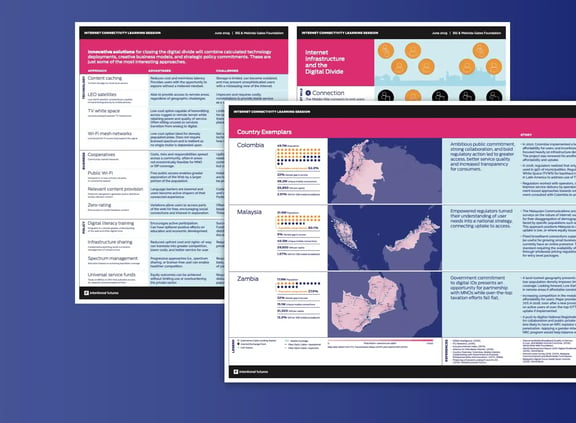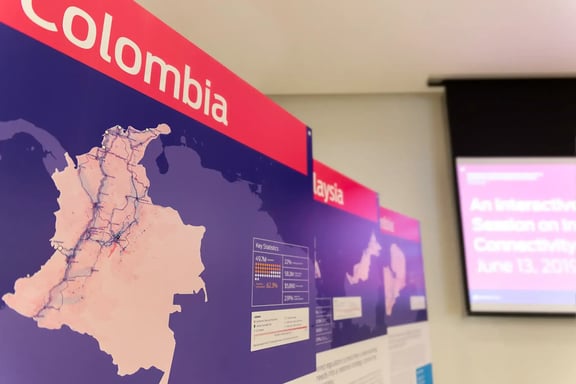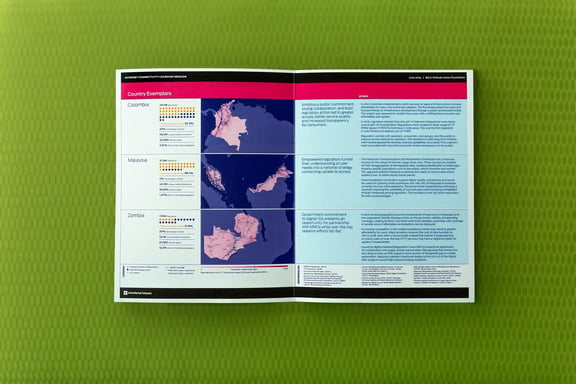Internet Access for All
Overview
The Pathways for Prosperity Commission on Technology and Inclusive Development wanted to create clarity around what governments, business leaders, and the philanthropic sector could do to improve the access and value of the internet globally and to help clarify investment priorities that would deliver the greatest good for the greatest number.
To help them, we conducted cross-sectoral research on policies, business models, and technologies to identify best practices for different stakeholders. The solutions that surfaced from our research were mostly piecemeal – ways to provide connectivity during natural disasters or to set up low-cost community internet cafes. We wanted to tackle the bigger issue: How can the global community get the remaining 4 billion people online and engaging in meaningful ways?
We organized the individual solutions into different combinations that could address some of the key challenges in deeper, more sustainable ways, and suggested solutions that could be taken to scale. We presented these various solutions to the commission in a learning session and summarized our research in a report called Combinations for Connectivity.
"We wanted to present developing countries, the private sector, and multilateral institutions with practical alternatives for better using technology based on hard evidence and best practice. The Intentional Futures team was a fantastic, creative partner in this endeavor, and they went beyond desk research into strategic, creative problem-solving." –John Norris, Deputy Director, Sustainable Security Program, Center for American Progress
What we made
In our presentation and the report that followed, Combinations for Connectivity, we detailed the advantages and disadvantages of each solution, and paired them with other approaches that would complement and improve their effectiveness or longevity. We illustrated these combinations with case studies that sharply illuminated the potential and pitfalls of some of these different solutions in real world settings.
For example, how could policy solutions combine to respond to the challenges of digital literacy and the need for locally relevant content? How could certain technology solutions realize their full potential when coupled with a context-specific business model?
One pairing with potential to deliver affordable connectivity to rural areas that improves connectivity and affordability that emerged was TV-White Space (TVWS) and spectrum regulation. TVWS refers to the buffer channels previously used for analog TV broadcasting that often sit unused. These frequencies can travel farther than alternatives, providing low cost internet access to people in remote or mountainous areas. However, these frequencies are often unregulated, which introduces risk to business investment.
For this combination, as with many others, collaboration between the public and private sector is necessary to ensure sustainability. Colombia’s use of TV-White Space (TVWS) is an example we featured in the learning session. Colombia incentivized investment by offering low-cost spectrum licenses for these frequencies, giving the private sector the ability to offer internet service to rural customers, where they previously had no offerings or only high cost options.
Impact
The Pathways for Prosperity Commission set out to catalyze country-level solutions to the digital divide. Through our presentation, the commissioners gained a deeper understanding of promising policy levers, business models, and technology. Our report informed recommendations the Commission made to the global community and country leaders, detailed in their Digital Manifesto, and there continues to be enormous appetite from developing countries for the pathways work and insights. We are honored to have our work be part of an important advancement towards universal internet access.




.webp?width=576&height=384&name=6373dceb2683dc8234e1daf9_20190618-_b3b1542%20(1).webp)
